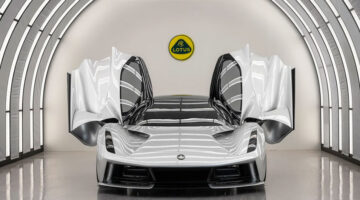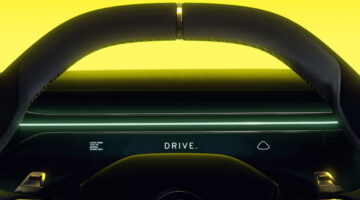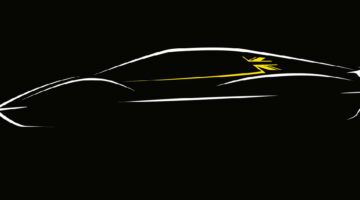With some trepidation, I try a third time and really chuck it in quite hard. The rears finally come unstuck and the rear slides sideways alarmingly quickly, leaving me scrabbling to wind on some lock and bring everything back into line. This is clearly something that owners would need to practice – the Lotus is not built for lairy slides, it’s built to handle. That said, I would love some track time in this, without nearby Armco to bash into.
We press on to more twisty roads, and I start stringing the bends together. The composure of the Evora really is impressive, the interaction between driver and road thrilling, with the Lotus acting as a conduit for the messages between tarmac and human, rather than a barrier. There’s a purity to the chassis and steering that you just don’t see that much these days outside of track specials. With the Sport button pressed, the exhaust opens up for a more rasping sound that adds harmony to the flow of the drive. The brakes are solid but progressive, and the car’s so light that it stops beautifully, turns in and gathers itself almost instantly.
The slight fly in the ointment is the IPS gearbox, which has been fine in auto mode for blatting up and down motorways, but on these twisty roads, in manual mode, it feels a bit hesitant, taking a fraction too long to change for my liking. The engine isn’t hugely torquey so benefits from being kept singing, and the delays can be a little frustrating. A manual model is available, but it’s likely to be the IPS that forms the vast majority of sales over here.
Our time with the Evora S soon starts to run out, and as if to underline the finality of the limit, the heavens open as we turn reluctantly for home. Based on my experience today, the Evora S is, for the driving enthusiast, a more-than-worthy rival to the likes of the Porsche Cayman S. But there’s a problem, and it’s the price. The base Evora in its native UK is some $30,000 cheaper than the entry-level Porsche 911 Carrera. In the UAE, the prices are almost identical. This Evora S, which in this market comes fully loaded with everything available for it, is $105,091, and for $5000 more you could get the faster, more powerful and, crucially, better-known 911 Carrera S. At this price, for all its capability – and it is very capable indeed – the Evora stops making sense. It doesn’t have the usability, the non-dynamic qualities and, in this region, the brand awareness that Porsche has in spades. If I had $110,000 to spend, it wouldn’t go on the Lotus, it would go to Stuttgart’s coffers. It the Lotus was Cayman money however, I’d have a very difficult decision on my hands to choose between them.
That’s a shame, because the Evora is a genuinely great car. It has a level of driver involvement that very few other cars can dream of, a connection to the road that rewards in spades, and its concessions to everyday use haven’t dimmed its appeal. Take one out on some great roads, and you can’t help but be impressed, which is hugely encouraging for its introduction to the UAE. Knock off a chunk of that price, and we’ll be very interested. We suspect the wider public, once they experience it, will be as well.
– FULL GALLERY OF SHOTS AVAILABLE HERE – CLICK –
Awesome selection of wallpapers available HERE
*ORIGINAL POST DATE: October 2013. An earlier version of this story referred to the Lotus being 200kg lighter than a Porsche Cayman. This was comparing kerb weight to unladen weight and was therefore an incorrect comparison – the Cayman S’s kerb weight is in fact lighter than the Evora S. The article has since been updated and we apologise for the error.
| Lotus | Evora S |
|---|---|
| Engine: | V6 / 3456cc / supercharged |
| Power: | 345bhp @ 7000rpm |
| Torque: | 295lb ft @ 4500rpm |
| Transmission: | Six-speed IPS automatic / rear wheel drive / ESP |
| Front suspension: | Double wishbone / coil springs / gas dampers / anti-roll bar |
| Rear suspension: | Double wishbone / coil springs / gas dampers / anti-roll bar |
| Brakes: | Vented and drilled discs / 350mm (front) / 332mm (rear) |
| Wheels: | 18-in (front) / 19-in (rear) |
| Tyres: | 225/40 ZR18 (front) / 255/35 ZR19 (rear) / Pirelli P-Zero |
| Weight (kerb) | 1437kg |
| Power-to-weight: | 232bhp per ton |
| 0-100kph: | 4.7sec |
| Top speed: | 269kph |



